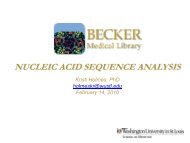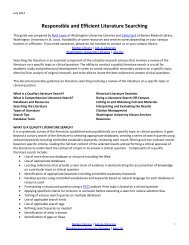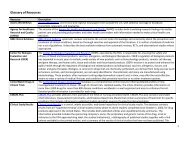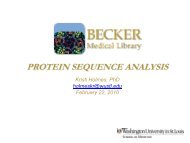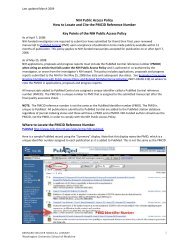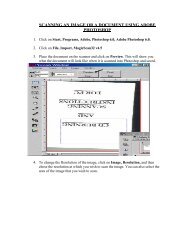DATA & SOFTWARE - Bernard Becker Medical Library
DATA & SOFTWARE - Bernard Becker Medical Library
DATA & SOFTWARE - Bernard Becker Medical Library
You also want an ePaper? Increase the reach of your titles
YUMPU automatically turns print PDFs into web optimized ePapers that Google loves.
Everything you ever wanted to know about<br />
<strong>DATA</strong> & <strong>SOFTWARE</strong><br />
(…but were afraid to ask)<br />
Presented in the Introduction to Genomic Medicine<br />
series on 2 May 2011<br />
Kristi Holmes, PhD<br />
Bioinformaticist, <strong>Becker</strong> <strong>Medical</strong> <strong>Library</strong><br />
Local and National Outreach Coordinator, VIVO (http://vivoweb.org)
Information<br />
• Consumption<br />
• How to find, assess,<br />
process, & apply<br />
• What do these results mean<br />
and how did I get them?<br />
• What do I do next?
ioinformatics
Outline<br />
• General concepts to keep in mind when<br />
thinking about data<br />
• Data sources<br />
• Necessary software and tools<br />
• Tutorials, classes, support resources<br />
• On the horizon…
information overload
Top 10 List: THINGS TO KEEP IN MIND WHEN<br />
THINKING ABOUT <strong>DATA</strong><br />
10 - Scope: What are you looking for?<br />
9 - Data quality: Depends heavily on data curation, validation can be<br />
difficult (huge range)<br />
8 - Freshness of data: Well-maintained databases with current<br />
information can indicate a higher quality database<br />
7 - Data quantity: Never assume completeness of a data set<br />
6 - Availability: Download restrictions and IP restrictions<br />
5 - Technical architecture: Interfaces which promote ease of use<br />
4 – Boolean Searching: AND, OR, NOT<br />
3 – “”,*,(): write better searches!<br />
2 – Use limits to narrow your search: again, what are you looking for?<br />
1 – Use information directories: collections of information
Top 10 List: THINGS TO KEEP IN MIND WHEN<br />
THINKING ABOUT <strong>DATA</strong><br />
10 - Scope: What are you looking for?<br />
9 - Data quality: Depends heavily on data curation, validation can be<br />
difficult (huge range)<br />
8 - Freshness of data: Well-maintained databases with current<br />
information can indicate a higher quality database<br />
7 - Data quantity: Never assume completeness of a data set<br />
6 - Availability: Download restrictions and IP restrictions<br />
5 - Technical architecture: Interfaces which promote ease of use<br />
4 – Boolean Searching: AND, OR, NOT<br />
3 – “”,*,(): write better searches!<br />
2 – Use limits to narrow your search: again, what are you looking for?<br />
1 – Use information directories: collections of information<br />
Adapted from: Baxevanis, A.D. and Ouellette, B.F.F., eds., Bioinformatics: A Practical Guide to the Analysis of Genes and<br />
Proteins, third edition. Wiley, 2005. ISBN 0-471-47878-4
Top 10 List: THINGS TO KEEP IN MIND WHEN<br />
THINKING ABOUT <strong>DATA</strong><br />
10 - Scope: What are you looking for?<br />
9 - Data quality: Depends heavily on data curation, validation can be<br />
difficult (huge range)<br />
8 - Freshness of data: Well-maintained databases with current<br />
information can indicate a higher quality database<br />
7 - Data quantity: Never assume completeness of a data set<br />
6 - Availability: Download restrictions and IP restrictions<br />
5 - Technical architecture: Interfaces which promote ease of use<br />
4 – Boolean Searching: AND, OR, NOT<br />
3 – “”,*,(): write better searches!<br />
2 – Use limits to narrow your search: again, what are you looking for?<br />
1 – Use information directories: collections of information<br />
Adapted from: Baxevanis, A.D. and Ouellette, B.F.F., eds., Bioinformatics: A Practical Guide to the Analysis of Genes and<br />
Proteins, third edition. Wiley, 2005. ISBN 0-471-47878-4
4 – Boolean Searching<br />
What is a Boolean Operator?<br />
• AND: To ‘AND’ two search terms together<br />
instructs Entrez to find all documents that<br />
contain BOTH terms<br />
• OR: To ‘OR’ two search terms together<br />
instructs Entrez to find all documents that<br />
contain EITHER term.<br />
• NOT: To ‘NOT’ two search terms together<br />
instructs Entrez to find all documents that<br />
contain search term 1 BUT NOT search<br />
term 2.<br />
http://www.ncbi.nlm.nih.gov/bookshelf/br.fcgi?book=helpentrez&part=EntrezHelp<br />
http://www.le.ac.uk/li/sources/subject3/physics/ist/boolean.html<br />
http://www.ncbi.nlm.nih.gov/books/NBK3837/#EntrezHelp.Entrez_Searching_Options
4 – Boolean Searching:<br />
Boolean Operators: Rules/Syntax in NCBI<br />
The Entrez search rules and syntax for using Boolean operators are:<br />
1. Boolean operators AND, OR, NOT must be entered in UPPERCASE (e.g.,<br />
promoters OR response elements).<br />
2. Entrez processes all Boolean operators in a left-to-right sequence. The order<br />
in which Entrez processes a search statement can be changed by enclosing<br />
individual concepts in parentheses. The terms inside the parentheses are<br />
processed first as a unit and then incorporated into the overall strategy. For<br />
example, the search statement: g1p3 AND (response element OR promoter)<br />
is processed by Entrez by ORing the terms response element OR promoter<br />
first and then ANDing the resulting set of documents with g1p3. g1p3 AND<br />
(response element OR promoter)<br />
3. See Entrez Searching Options for more information on using Boolean<br />
Operators and Entrez Search Field Qualifiers. (this is a great resource!)<br />
Geer, R.C., Messersmith, D.J, Alpi, K., Bhagwat, M., Chattopadhyay, A., Gaedeke, N., Lyon, J., Minie, M.E., Morris, R.C., Ohles, J.A., Osterbur, D.L. &<br />
Tennant, M.R. 2002. NCBI Advanced Workshop for Bioinformatics Information Specialists. [Online] http://www.ncbi.nlm.nih.gov/Class/NAWBIS/.<br />
[date cited April 29, 2011]
3 – “” * ()<br />
Write better searches!<br />
• The use of quotation marks can change your search results<br />
significantly!<br />
– 1000 Genomes Project = 6,980,000 results<br />
– “1000 Genomes Project” = 125,000 results<br />
• The use of wildcards can change your search results<br />
significantly!<br />
– http://www.ncbi.nlm.nih.gov/pubmed?term=carbo*<br />
• The use of parentheses can change your search results<br />
significantly!<br />
– g1p3 AND (response element OR promoter) retrieves 9 records<br />
– g1p3 AND response element OR promoter retrieves 148,553 records<br />
http://xkcd.com/859/
2 – Use limits to narrow your search<br />
Enter your search in command language, indicating field qualifiers in square<br />
brackets [].<br />
• Syntax: term[field] BOOLEAN term[field] BOOLEAN term[field] etc.<br />
• Boolean operators (AND, OR, NOT) must be written in UPPER CASE<br />
Boolean operators are processed from left to right unless parentheses are used<br />
for nesting. If parentheses are used, the portions of the query in parentheses<br />
will be processed first, then the remaining Boolean operators will be<br />
processed from left to right.<br />
• LIST of Search Fields and Qualifiers and search fields available by database<br />
• Search results for field AND handbook[book]<br />
presenilin 1[titl] AND human[orgn] (Nucleotide database)<br />
Geer, R.C., Messersmith, D.J, Alpi, K., Bhagwat, M., Chattopadhyay, A., Gaedeke, N., Lyon, J., Minie, M.E., Morris, R.C., Ohles, J.A., Osterbur, D.L. &<br />
Tennant, M.R. 2002. NCBI Advanced Workshop for Bioinformatics Information Specialists. [Online] http://www.ncbi.nlm.nih.gov/Class/NAWBIS/.<br />
[date cited April 29, 2011]
• Properties field<br />
– molecule type (e.g., biomol_genomic[prop])<br />
– GenBank division (e.g., gbdiv_EST[prop])<br />
– gene location (e.g., gene in<br />
mitochondrion[prop])<br />
– source database (e.g., srcdb_refseq[prop])<br />
– citation status (e.g., cit_inpress[prop])<br />
– HTGS phase (e.g., htgs_phase3[prop])<br />
– other features (e.g., partial[prop],<br />
complete[prop])<br />
– submission types (e.g., population<br />
study[prop])<br />
• Feature Key (nucleotides only)<br />
• Sequence Length<br />
• Molecular Weight (proteins only)<br />
• Organism (uses Taxonomy db)<br />
Some search fields at<br />
NCBI<br />
Use field limits to see what you’re looking for…<br />
http://www.ncbi.nlm.nih.gov/books/NBK3837/#EntrezHelp.Entrez_Searching_Options
1 – Take advantage of information<br />
directories<br />
Nucleic Acids Research Database Issue<br />
– The 2011 Nucleic Acids Research Database Issue and online Database Collection. Galperin MY and Cochrane GR,. Nucl. Acids<br />
Res. (2011) 39 (suppl 1): D1-D6. doi: 10.1093/nar/gkq1243<br />
– Complete table of contents for the NAR database issue (Tip: to see the table of contents from the database issue for a<br />
previous year, just reduce the volume number in the URL (to the complete table of contents) by one.)<br />
– Searchable database of summary papers<br />
Nucleic Acids Research Web Server Issue<br />
– 2010 Web Server complete table of contents<br />
– Searchable database of web server summaries<br />
Nucleic Acids Research Methods index<br />
Bioinformatics Links Directory (described in an NAR article, July 2007 web server issue)<br />
ExPASY Life Science Directory<br />
– >1000 links on a single page, organized by category<br />
BioMed Central Databases collection<br />
Biocatalog by EBI<br />
– database providing summary and access information for a wide range of molecular biology databases and software; browse<br />
category of interest or search complete db<br />
Online Bioinformatics Resources Collection (OBRC) from the HSLS, University of Pittsburgh<br />
Max Planck Society bioinfowiki<br />
– 250 tools and resources which have been developed within the institutes and research groups of the Max Planck Society.
Information sources…<br />
data sources
Top 2 List: <strong>DATA</strong> SOURCES<br />
2 – biological data<br />
(NCBI, EBI, many others)<br />
1 – bibliographic data<br />
(Web of Science, Scopus, PubMed)
Tools…
Top 10 List: SOME INTERESTING TOOLS<br />
10 – Sequence Manipulation Suite<br />
9 – BLAST<br />
8 – Blink<br />
7 – Flink<br />
6 – Multiple sequence alignment software<br />
5 – Partek<br />
4 – JMP Genomics<br />
3 – GeneGo Metacore<br />
2 – Genome Browsers (UCSC, MapViewer, G-Browse)<br />
1 – BioMart
10 – Sequence Manipulation Suite<br />
Sequence Manipulation Suite<br />
– A collection of JavaScript programs for<br />
generating, formatting, and analyzing short<br />
DNA and protein sequences. It is commonly<br />
used by molecular biologists, for teaching,<br />
and for program and algorithm testing.<br />
– See the about the SMS page for more<br />
information about individual Sequence<br />
Manipulation Suite programs.<br />
http://www.ualberta.ca/~stothard/javascript/index.html
9 – BLAST<br />
Basic Local Alignment Search Tool<br />
• BLAST finds regions of local similarity between sequences. The<br />
program compares nucleotide or protein sequences to<br />
sequence databases and calculates the statistical significance of<br />
matches. BLAST can be used to infer functional and<br />
evolutionary relationships between sequences as well as help<br />
identify members of gene families.<br />
• BLAST assembled genomes<br />
• Basic BLASTs (BLASTn, BLASTp, BLASTx, tBLASTn, tBLASTx)<br />
• Specialized BLASTs can accomplish a host of tasks<br />
• http://blast.ncbi.nlm.nih.gov/Blast.cgi
9 – BLAST<br />
Specialized BLAST<br />
Make specific primers with Primer-BLAST<br />
Search trace archives<br />
Find conserved domains in your sequence (cds)<br />
Find sequences with similar conserved domain architecture<br />
(cdart)<br />
Search sequences that have gene expression profiles (GEO)<br />
Search immunoglobulins (IgBLAST)<br />
Search using SNP flanks<br />
Screen sequence for vector contamination (vecscreen)<br />
Align two (or more) sequences using BLAST (bl2seq)<br />
Search protein or nucleotide targets in PubChem BioAssay<br />
Search SRA transcript and genomic libraries<br />
Constraint Based Protein Multiple Alignment Tool<br />
Needleman-Wunsch Global Sequence Alignment Tool<br />
Search RefSeqGene<br />
Search WGS sequences grouped by organism
8 – Blink (BLAST Link)<br />
• The output includes the positions of up to<br />
200 BLAST hits on the query sequence,<br />
scores, and alignments. (View sample<br />
BLink output for human MLH1 protein.)<br />
• BLink offers a variety of display options,<br />
including the distribution of hits by<br />
taxonomic grouping, the best hit to each<br />
organism, the protein domains in the<br />
query sequence, similar sequences that<br />
have known 3-D structures, and more.<br />
• Additional options allow you to specify<br />
which taxa you would like to exclude,<br />
increase or decrease the BLAST cutoff<br />
score, or filter the BLAST hits to show only<br />
those from a specific source database,<br />
such as RefSeq or Swiss-Prot.<br />
• http://www.ncbi.nlm.nih.gov/sutils/static/<br />
blinkhelp.html
7 – FLink<br />
BioSystems<br />
Conserved Domain Database (CDD)<br />
Gene<br />
Protein<br />
PubChem BioAssay<br />
PubChem Compound<br />
PubChem Substance<br />
PubMed<br />
Structure (Molecular Modeling Database, MMDB)<br />
http://www.ncbi.nlm.nih.gov/Structure/flink/docs/flink_help.html<br />
FLink: Frequency weighted links [Internet]. Bethesda (MD): National <strong>Library</strong> of Medicine (US), National Center for<br />
Biotechnology Information. 2010 - [cited May 1, 2011]. Available from: http://ncbi.nlm.nih.gov/Structure/flink/flink.cgi
6 – Multiple sequence alignment tools<br />
Multiple Sequence Alignment (MSA) is generally the alignment<br />
of three or more biological sequences (protein or nucleic acid)<br />
of similar length.<br />
ClustalW2 MSA<br />
Kalign MSA<br />
MAFFT MSA<br />
MUSCLE MSA<br />
T-Coffee MSA<br />
WebPRANK - phylogeny-aware multiple sequence<br />
alignment program<br />
http://www.ebi.ac.uk/Tools/msa/
5 – Partek Genomic Suite<br />
• Partek Genomics Suite is a comprehensive<br />
suite of advanced statistics and interactive<br />
data visualization specifically designed to<br />
reliably extract biological signals from noisy<br />
data. The software is unique in supporting all<br />
microarray and next generation sequencing<br />
technologies, allowing for analysis of multiple<br />
applications in one complete solution.
Integrated Genomics in<br />
Partek Genomics Suite
4 – JMP Genomics<br />
• JMP Genomics is a<br />
SAS-based suite of<br />
tools to analyze<br />
Expression, Genetics,<br />
Copy Number, Exon<br />
and Proteomics data.
3 – GeneGo MetaCore<br />
• Integrated knowledge<br />
database and software suite<br />
for pathway analysis of<br />
experimental data and gene<br />
lists<br />
• Data types includes microarray<br />
and sequence-based gene<br />
expression, SNPs and CGH<br />
arrays, proteomics,<br />
metabolomics, Co-IP pull-out<br />
and other custom interactions
http://becker.wustl.edu/resources/bioinfo/software.html
2 – Genome Browsers<br />
• Genome browsers organize tremendous volumes of<br />
genome sequence data, adding context to genomic<br />
sequence with many types of annotations.<br />
• Several major genome web browsers are widely used<br />
to search, retrieve, and display genome information<br />
for human and numerous other species.<br />
Ensembl, Map Viewer, UCSC<br />
Genome Browser, and the<br />
Integrated Microbial Genomes<br />
(IMG) browser, Gbrowse<br />
http://www.openhelix.com/cgi/tutorialInfo.cgi?id=65
1 – BioMart<br />
BioMart is an open source query-oriented data management system developed<br />
jointly by the Ontario Institute for Cancer Research (OICR) and the European<br />
Bioinformatics Institute (EBI).<br />
http://www.biomart.org/
Top 10 List: INTERESTING TOOLS<br />
10 – Sequence Manipulation Suite<br />
9 – BLAST<br />
8 – Blink<br />
7 – Flink<br />
6 – Multiple sequence alignment software<br />
5 – Partek<br />
4 – JMP Genomics<br />
3 – GeneGo Metacore<br />
2 – Genome Browsers (UCSC, MapViewer, G-Browse)<br />
1 – BioMart
…and this is just the tip of the iceberg!
Want to learn more?
Top 8 List: WHERE TO LEARN MORE<br />
& TRY THINGS OUT<br />
• NCBI Education:<br />
http://www.ncbi.nlm.nih.gov/education/<br />
• EBI Training: http://www.ebi.ac.uk/training/<br />
• Random resources (wikis, slides, etc.)<br />
• Training through the library (NCBI training in July)<br />
• Consultations through the library<br />
• Training through the CRTC and CBMI<br />
• The Research Pod:<br />
http://becker.wustl.edu/services/researchpod.html<br />
• OpenHelix: http://www.openhelix.com/
TUTORIALS<br />
• 2Can Support Portal The bioinformatics educational resource.<br />
• NCBI Education site<br />
• OpenHelix Tutorials – <strong>Becker</strong> <strong>Medical</strong> <strong>Library</strong> subscribes to the<br />
entire suite and it is available across both campuses. You will<br />
need to register on the OpenHelix site using your “wustl.edu”<br />
email address for access.<br />
• All tutorials<br />
• Free tutorials
On the horizon…
Top 5 List: ON THE HORIZON<br />
• Visualization<br />
• The semantic web<br />
• Social networking<br />
• Data (curation, sharing, preservation)<br />
• Nanopublications
SciMaps<br />
Visualization<br />
http://www.computerworld.com/s/article/9215504/22_free_tools_for_data_visualization_and_analysis
The Semantic Web<br />
• The Semantic Web is a "web of data" that enables machines to understand the<br />
semantics, or meaning, of information on the World Wide Web. It extends the network<br />
of hyperlinked human-readable web pages by inserting machine-readable metadata<br />
about pages and how they are related to each other, enabling automated agents to<br />
access the Web more intelligently and perform tasks on behalf of users. (Wikipedia)<br />
Information is stored using the Resource Description Framework (RDF).<br />
Data are structured in the form of “triples” as subject-predicate-object.<br />
Concepts and their relationships use a shared ontology to facilitate the exchange<br />
of data from multiple sources and for multiple purposes.<br />
• By storing data in RDF and using standard ontologies, the information can either be<br />
displayed in a human readable web page or delivered directly to other systems as RDF.<br />
This allows data to be harvested, aggregated, and integrated into the Linked Open Data<br />
cloud.<br />
• Tools that use and repurpose Linked Data are increasing in popularity and are likely to<br />
become a significant part of the research work flow in the years to come.<br />
http://en.wikipedia.org/wiki/Semantic_Web<br />
http://en.wikipedia.org/wiki/Resource_Description_Framework<br />
http://computer.howstuffworks.com/semantic-web1.htm
Linked Open Data<br />
http://richard.cyganiak.de/2007/10/lod/lod-datasets_2010-09-22_colored.html
VIVO: a semantic web-based<br />
collaboration and profiling<br />
application at WU and other<br />
institutions<br />
vivo.wustl.edu
Data<br />
Data management and<br />
dissemination policies:<br />
http://figshare.com/<br />
http://datadryad.org/<br />
…etc.
nanopublications<br />
Some reading:<br />
• Axton M (2011) Crowdsourcing human mutations. Nature<br />
Genetics 43: 279.<br />
• Groth, P., Gibson, A., & Velterop, J. (2010). The anatomy of a<br />
nanopublication. Information Services and Use, 30(1), 51-56.<br />
• Giardine B et al (2011) Systematic documentation and analysis<br />
of human genetic variation using the microattribution<br />
approach. Nature Genetics 43: 295-301.<br />
• Mons, B, et al. (2011). The Value of Data. Nature Genetics,<br />
Vol. 43, No. 4. 281-283.
Image credits<br />
• http://www.joedeacon.com/news%20archive/data%20loss/blue_data.gif<br />
• http://upload.wikimedia.org/wikipedia/commons/e/e1/Blind.JPG<br />
• http://www.flickr.com/photos/dirtysouth/2982720117/<br />
• http://www.flickr.com/photos/thevlue/5617535720/<br />
• http://www.indiamike.com/photopost/data/500/IMG_1836.JPG<br />
• http://www.flickr.com/photos/dmguz/5672808319/<br />
• http://www.flickr.com/photos/kyle_johnson/2887121154<br />
• http://www.patricktaylor.com/uploads/dclassicswiss1.jpg<br />
• http://www.genego.com/metacore.php<br />
• http://www.flickr.com/photos/jazzysteps/5556449519<br />
• http://www.flickr.com/photos/ghb624/1356102993<br />
• http://www.flickr.com/photos/plantreesplease/2679305152/<br />
• http://hameed.deviantart.com/art/Horizon-Widescreen-Wallpaper-<br />
19060656<br />
• http://www.flickr.com/photos/goobi/4021009835/




